ABSTRACT
Title
Orthodontics and the Pandemic: Long-Term Consequencess
Purpose
Review of topics related to orthodontics and the COVID19 pandemic.
Materials and Methods
Originally planned as a Critical Appraisal of select research questions, it became evident there are insufficient studies; rather, this is a comprehensive review of the scientific literature, professional news sources, and lower tier publications.
Results
The effect of the pandemic on orthodontic private practice and orthodontic education starting in March 2020 was keenly felt as most closed completely or opened for emergencies only. When practices reopened, it was realized that orthodontic care was urgent – patients could not wait for months without continuing their treatment. Orthodontists were confronted with the need to make broad and costly modifications to the way they practiced in a short time. 15 Changes included full personal protective equipment, increased disinfection protocols, airflow considerations, and fewer patients seen with longer appointments and longer workdays. Orthodontic residencies closed for 3 months or more, and like private practices, were forced to make the same changes while trying to ensure residents received the training and experience required to graduate. Fortunately, fifteen months later practices in most countries are 20 returning to normal levels of income and production, albeit at higher costs.
Conclusion
Changes in infection control, airflow in an office, aerosol generation, and the trend towards intraoral scanning and the contact-less or paperless office are probably permanent. Orthodontists must also be aware of their obligation as health providers interested in the overall well-being of their patients.
Introduction
The SARS-2/COVID19 pandemic is the most important worldwide event in recent times. This paper originally sought to present a broad, evidence-based review of the literature to answer key questions driven by the pandemic in a landscape lacking solid scientific content. In the early summer of 2020, the American Association of Orthodontists Council on Scientific Affairs was charged with examining the literature to determine the best evidence for questions pertaining to COVID-19 and its impact on the practice of orthodontics [Citation1] and a systematic review was published in the [Citation2]. Both articles were thoroughly researched but the findings were only marginally useful due to a lack of good evidence. Even today (late May 2021), a systematic review investigating relevant orthodontic pandemic research questions is not feasible because of the rapidly changing events and explosion of literature presented in both the scientific literature and other sources. A Cochrane search using the two terms Covid19 and Orthodontics returned no hits in May 2021. This Review Article instead is a summary of how the pandemic impacted the profession, and what, if any changes are long lasting or permanent. Much of the report is based primarily on what has happened in the United States where the greatest impact of the virus has been experienced.
Orthodontists in private practice in the USA have always had a cavalier attitude towards infection control. They treat a healthy, young population and rarely penetrate soft tissue or bone. There is little splatter and even during the AIDS crisis of the 1980s there was no evidence of an orthodontic patient being infected in a dental office. In April 2020, an orthodontic magazine featured an office where the doctor was practicing in an aloha shirt, not atypical clinic wear for an orthodontist in the US. When the pandemic started, orthodontists, like most people, assumed the disease would follow the pattern of previous viruses (SARS1, H1N1, MERS, etc) that only affected certain countries and was self-limiting. This author spoke at the Washington state orthodontic society meeting the first weekend in February 2020. A few weeks later a large (15,000 attendees) dental meeting was held in Vancouver, British Columbia and the first outbreak occurred; one dentist later died. The rest of the meetings were cancelled as the pandemic took off in New York City, Europe (especially Italy, Spain, United Kingdom, and France) and where it started and ended first, the Peoples Republic of China. Most countries were caught completely unprepared – despite warnings for years from public health officials about the inevitability of a worldwide pandemic, as usual, governments put prevention on hold in favour of more politically favourable programs. No one was spared from the pandemic as entire countries literally shut down overnight. Borders closed and entire countries closed schools, businesses, stores, and industries. For the first time in several generations, a life changing event occurred globally. Orthodontics was not spared but most thought this would pass quickly, and many scoffed when the epidemiologists said the pandemic would last into 2021. As of the end of May 2021 there is finally optimism that the virus has been tamed. In the USA, which suffered 600,000 fatalities, key indicators are finally approaching the lowest levels since the pandemic started.
What happened to orthodontists? There was a huge variation in practice – many dental offices around the world closed in March 2021 either voluntarily or by mandate, depending also on the country’s case rates. In most of Asia dental offices remained open as usual [Citation3]. Dentistry was classified as an essential business in most countries [In the UK for example, see Citation4] – and therefore allowed to remain open – but in many regions dental offices closed voluntarily, except to see emergencies. For example, in California, the governor included dentistry as essential business, but the California Dental Association advised all offices to close except for emergencies to make PPE more available to hospitals. The Centers for Disease Control and the American Dental Association made similar recommendations nationally in the US lasting several weeks. It became obvious that as the lockdowns continued, orthodontic patients became ‘urgent’ care instead of routine [Citation5–8]. When the second surge arrived in December, however, dental practices were unaffected. Most dental schools closed completely in March 2020 except for hospital based programs where they could use the specialized negative air pressure rooms specifically designed for highly infectious patients.
According to the COVID-19 Economic Impact – State Dashboard published regularly by the Health Policy Institute of the ADA, in March 2020, only 1.5% of orthodontic practices in the US were open. 73% were seeing emergencies only, and 25% were closed completely. Six months later 39% were open normally and 61% on a limited schedule. In May 2021 the number is up to 59% and 41% respectively.
A period of uncertainty
Transmission of the virus not just in dental offices, but everywhere, dominated the news. As societies shut down (32% in March 2020 were in lockdown) there was a worldwide panic due to a lack of good scientific evidence, and the promotion of pseudoscience by the media and governments. For example, a study from the New England Journal of Medicine [Citation9] was widely quoted as proof the virus was transmitted as a ‘fomite’ meaning on the surface. This study seemed to show that the virus could live a long time on a variety of surfaces. This resulted in panic behaviour as people rushed to the stores, buying up supplies of disinfectant (30% more sold in 2020 than 2019) and cleaning supplies. Businesses and even air lines proudly showed off their disinfectant sprayers. Most experts were doubtful of SARS2 fomite transmission, but it was not until the summer that the evidence came out that in fact, it was almost exclusively aerosol transmission not fomite. Studies showed that the virus can be detected for a long time on a surface, but it is not infectious [Citation10–12]. Professor Goldman stated, ‘It is the corpse of the virus you find.’ Yet the WHO, which in February of 2020 stated masks were not necessary, still insisted in October 2020 that the virus was transmissible on surfaces.
Changes in clinical practice
Based upon recommendations by the Center for Disease Control and other regulatory agencies, orthodontists were compelled to make many changes when they reopened for business around the world in early summer 2020.
, 2 and 3 show the many modifications most orthodontists adopted in their practices. There remains much confusion about Personal Protective Equipment (PPE) and how much is necessary. Because COVID19 proved to be such a deadly pathogen, the profession erred on the side of caution. Some orthodontists bemoaned the recommended changes [Citation13] but the outcomes are convincing that this worked. Jackie Dorst, the leading expert on orthodontic practice and infection control, and key member of the American Association of Orthodontists COVID19 Task Force, stated ‘There is no occurrence of a direct transmission (patient to clinical staff and vice-versa) in an orthodontic office.’ Many offices had outbreaks, but they were they were due to staff eating or drinking together. The strict infection control modifications may have seemed like overkill during the spring of 2020, but the key was to make patients and staff feel safe, and this was very successful.
Table 1. FRONT DESK
Unfortunately these adaptations have come at a steep price; literally, as the cost of PPE has skyrocketed. A box of vinyl gloves went from less than $3 to up ten times higher [Citation14,Citation15]. Similar price increases have occurred across the board and show no signs of decreasing. This whilst according to a survey by the ADA, orthodontist practice income dropped. (December 2020) Dental practices benefited slightly from federal government programs in the US that offset some losses. In the US the Paycheck Protection Program has been very popular among dentist as the ‘loans’ did not have to be paid back. Funds have been used mostly for retaining staff and covering practice expenses like mortgage and utilities and supplies [Citation16]. Recently, legislation has been proposed to compel the dental insurance industry to help cover the extra costs. The largest insurer in the US reported an increase in profit of 44% comparing the first quarter of 2020 to 2019 [Citation17].
Early in the pandemic, there was a huge interest in teledentistry, and it seemed that the pandemic would be a plus for practices doing clear aligners. In the long run, however, as practices returned to normal operations, there is no evidence of changing the trend in teledentistry and clear aligners that was already ongoing. The pandemic certainly increased interest in going paperless and plaster less and using social media to keep patients fully informed.
As the vaccination rollout gained momentum around the worldwide, the role of dentists as true health providers emerged and dentists, including orthodontists, were given authorization to administer intramuscular (IM) injections for the COVID19 vaccine. For example, in Japan, dentists had not been authorized to vaccinate patients but during a declared state of emergency over COVID-19, a special measure allowing for this has been approved. In the USA, as of May 2021 45 out of the 50 states permit licenced dentists to administer the vaccine but there is no data on the number of orthodontists participating. In , orthodontic specialist Dr Amy Gimlen of El Segundo, California prepares to administer the shot at a Los Angeles County centre for vaccination.
Figure 1. Board certified orthodontist Dr Amy Gimlen prepares to give COVID19 immunizations at a county vaccination centre in April 2021. The pandemic reminded orthodontists that they are part of the health team
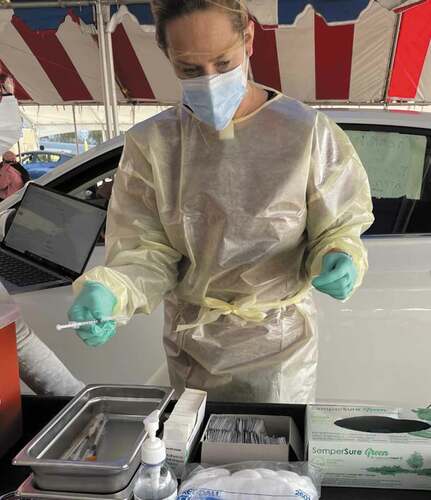
Figure 2. Social distancing seating in the waiting room at the USC orthodontic clinic, Los Angeles, California in May 2021
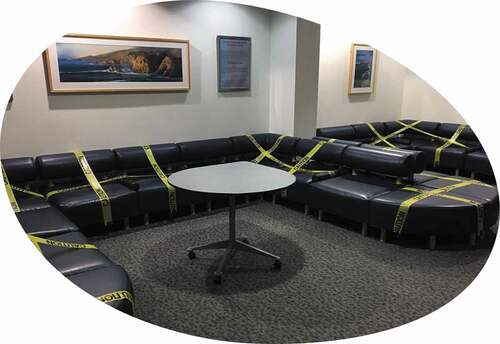
Most of these modifications were adopted despite a lack of solid evidence that they would prevent transmission or infection. Citation1,looked at many of these procedures for justification from the literature, and there was little evidence, at least in June 2020. For example, the use of screening questionnaires (e.g. Do you have a fever? Do you have a stomachache? Etc] that are asked of patients continues today yet no one knows how many patients honestly answered the questions and more importantly, did these questionnaires [which are time consuming and require personally identifiable information) prevent disease transmission? A recent study showed that these questionnaires do not, in fact, identify asymptomatic patients who are contagious. Citation18,Another example is the use of preprocedural mouthrinses. The CDC recommended their use and subsequently studies have shown that at least, in vitro they are effective against the coronaviruses. Investigations comparing types of rinses show no real differences [Citation19–21], and commercially available oil-based mouthrinses (e.g. Listerine Mint) are much cheaper and patients are familiar with them. Regardless the reduction is temporary, as virus from the nose and pharynx rather rapidly returns to the oral cavity. High speed suction as opposed to saliva ejectors must be used and the addition of a high volume extraoral evacuator (see ) reduces aerosol and splatter to baseline levels [Citation22]. Furthermore, [Citation23], found a 95% reduction in droplet splatter when used at maximum settings and minimal distance in an in-vitro experiment. More specific to orthodontics are the droplets and particles produced by debanding with a slow speed handpiece. [Citation24],found that contamination was highly localized in their in-vitro experiment. Debonding with a high-speed air handpiece with air and water spray was discontinued by most practices and replaced with slow speed or hand removal of composite with ‘scrapers.’ Most ortho programs stopped using the three-way syringe for bonding but the manuscript by [Citation25],seemed to show that its use caused no increase in aerosol production.
Figure 3. AGDP appointment in the orthodontic clinic. The extraoral high volume evacuator/filter (Novavox N19) in close proximity to the workspace
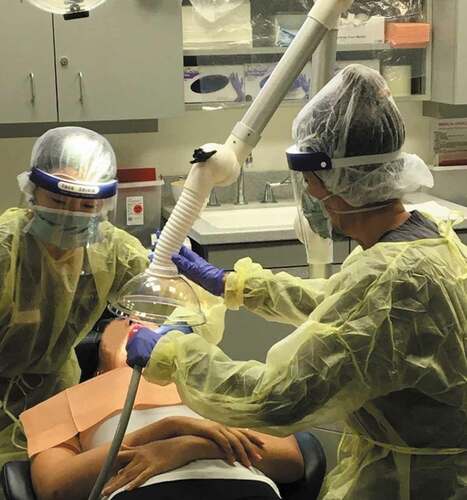
The genesis for this entire discussion of PPE is Aerosol Generating Procedures (AGP) or Aerosol Generating Dental Procedures [AGDP) [Citation26]. Virdi and colleagues in January 2021 stated, ‘Despite there being plentiful national and international guidance available, there remains ambiguity as to what constitutes an aerosol-generating dental procedure.’ [Citation27],identified six areas of confusion that need to be clarified in researching AGDP: 1] quantification of aerosol bioload created during various AGDPs, 2) establishing the required infectious doses of individual pathogens, 3) identification of environmental factors that influence aerosol spread in dental offices, 4) assessment of patient susceptibility based upon individualized characteristics, 5) epidemiologic surveillance to identify the true rates of situational-specific spread, and 6) assessment of infectious disease prevalence in dental health care providers [DHCPs) and dental office personnel. These areas must be addressed with well designed, funded research by the dental community.
[Citation28], wrote an excellent summary of dental aerosols in the CDA journal in October 2020. Their two main conclusions were prophetic – there was more risk from infection in non-clinical areas due to unmasked contacts, and public perception that dental offices are unsafe would occur.
Orthodontic education
“Will the DDS class of 2021 be practice ready? “asked the author of a recent article in the Journal of the American Dental Asssociation [Citation29]. In answering their own question, they were confident that the educational standards would be upheld by the adaptations and new teaching methods designed to ensure competency in this class. What concerned them was the lack of community service opportunities, speciality rotations, and global service but not stated was the unique opportunity these students had to understand racism and prejudice outside of a closed learning system. In Scotland all three dental schools set back the graduation time of the class of 2021 by at least six months to gain more experience with AGDP.
Orthodontic programs were similarly affected but have recovered nearly completely. Patients are returning and clinic operations in general are moving back to pre-pandemic levels, however, there were many changes made that will affect the programs for a long time. In the US, accreditation of ortho programs was delayed by a year and virtual site visits (the every-seven-years inspection by the ADA Council on Dental Accreditation) are being planned.
All clinic adaptations previously discussed for private practice were also done in residency programs, mostly to a higher degree. These additional costs incurred by dental schools [Citation30] and ortho programs were significant. Upon reopening orthodontic programs had to follow much tighter restrictions imposed by their parent institutions. All clinical staff, residents, and faculty were required to wear full PPE including fit-tested N95s. . Some schools required either patients or staff or both to be Covid tested regularly. Many schools installed expensive negative air pressure and high-volume air evacuation and cleaning systems. See . An ACH (Air Change per Hour) of 6–8 is desirable. (Source: Ventilation and Air Quality for Reducing Transmission of COVID-19. Washington State Health Dept, DOH Publication 33–256, October 2020.) Programs that were not already using electric handpieces installed or made plans to acquire them quickly noting the advantages in terms of efficiency of composite removal [Citation31] and reduced aerosol. (See below on AGP). Even more so than private practice, programs had to extend appointment times, and social distancing (distance between chairs) were rigidly enforced. Tooth brushing stations were closed off, and at many programs, impressions abruptly became a thing of the past replaced with intraoral scanning for all ortho lab procedures and devices.
Figure 4. Left: Pre COVID. Right: Present day. Personal protective equipment currently required for all patients. Note surgical scrubs, face shield, N95 respirator, disposable gown. Not pictured: Surgical bonnet, booties, gloves. It is likely that this complete kit will only be required for AGDP when pandemic conditions return to normal
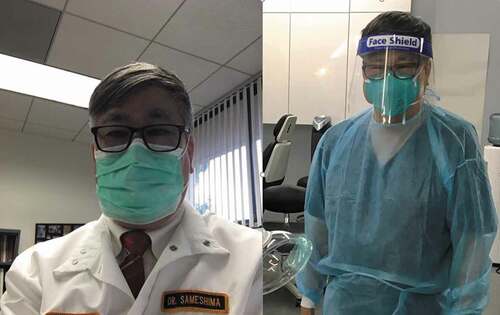
Figure 5. The INLINE2000 negative air machine – (Inline distributing, Sylmar, California, USA.) delivers airflow of 1,900 on High and 1,200 on Low (cfm). Three of these industrial grade units were installed in the USC orthodontic clinic to produce a minimum of 6 ACH. The units exhaust outside via the roof
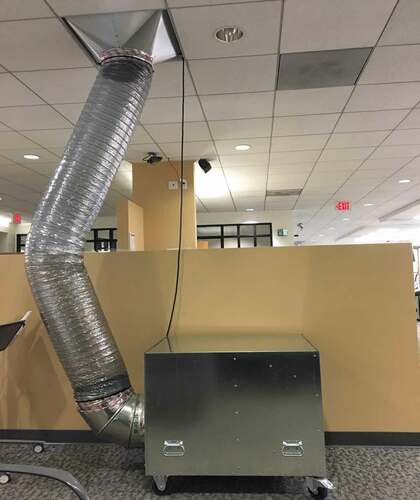
The American Dental Association reported 50% drop in patients from 2019 to 2020 at US Dental Schools and 42% mean drop in revenue [Citation30]. Resident case numbers, starts have been affected adversely but most programs (and private practices) have recovered even through the second or third ‘surges.’ Orthodontics has been largely perceived to be safe by the public, and patients who have been delaying dental and orthodontic visits are returning.
Remote learning
Orthodontic programs were forced to adapt quickly with in-person classes of any type banned completely. For most of America this started in mid-March and continues today (May 2021). The word ‘ZOOM’ acquired a new meaning and became a verb. Rules on testing and attendance had to be changed. At first it was novel and interesting, but at the pandemic stretched onward, most ortho residents and faculty became disenchanted with this. A debate has been generated on whether individual programs should develop their own teaching material with teachers qualified to teach all the diverse subjects an orthodontist needs or use external resources. Some argue that most learning could be web-based recorded material that everyone can access. In 2020 the American Association of Orthodontists made their entire archive available to residency programs to help supplement courses and fill unused clinic hours. An exemplary series of live lectures that were evidence-based were offered for free for several weeks by the Angle Society of Europe and the Eastern component of the US Angle Society. Over 3000 residents worldwide took advantage of this.
The US CODA standards for advanced education in orthodontics include one for public health. Certainly, orthodontists need more awareness about public health and the role we play in promoting overall health and well-being. It was apparent that dental residents everywhere need a much stronger scientific background.
Surveys of graduate orthodontic programs
Kau and Sameshima [Citation32–34) conducted three surveys of all North American orthodontic programs during the pandemic year. The first was done at the end of March 2020. 49 programs (out of 63) responded. All were closed and 95% reported a significant impact on revenue. 54% were concerned about lost clinic time for residents. The next survey was in July 2020. Only one program was still closed but 85% were working at 75% or less of capacity probably due to ‘social distancing.’ Programs were starting to use AGP but 32% used special negative air rooms, 16% had barriers or special areas of the clinic, and one fifth did not do AGP. Two thirds of programs required full PPE all day in the ortho clinic including N95masks. 25% of programs had N95 shortages. Several programs reported that residents from foreign countries had not been able to return due to travel restrictions. In the clinic most programs did not utilize space completely, with fewer residents in the clinic at a time. 60% of programs reported longer appointment times (presumably to accommodate increased decontamination procedures), and 45% reported having to extend clinic hours. The majority of programs were satisfied with online teaching but only 20% said they would continue. The last survey of programs in January 2021 reported all programs were open, but capacity was still reduced. Two-thirds had returned to normal clinic hours and appointment length. 13% were using teleorthodontics for initial exams, and there was no increase in clear aligner cases. 50% reported that not all of their faculty had returned to teach – many institutions forbid at-risk individuals from working in the clinic and this survey was done just when vaccinations were starting. 26% of programs reported having difficulty with N95 mask compliance – this indirectly showed that some part-time faculty were not wearing N95s in their practices. The survey showed that only 8% of programs were back to in-person classes, but 58% were allowed to do hands-on courses like typodont courses in person. One-third of programs reported salary or benefits reduction for orthodontic faculty. This will not help the already critical shortage of qualified faculty. Only 2 out of 38 programs did orthodontic admissions in person. The rest interviewed online. Only 20% liked it enough to change permanently. The overall impression from all three surveys was that orthodontic programs had to adapt quickly and often, and there was more uniformity among programs than expected despite highly disparate state and provincial pandemic regulations for health care.
Potential lasting changes caused by the pandemic
What can we anticipate as lasting changes induced by the pandemic in orthodontics? In clinical practice, there will be modest long-term changes. Orthodontists will make adaptations that are either demanded by patients and staff, or imposed by legal or regulatory body (e.g., OSHA) requirements. Clearly the cost of running a practice or ortho department will increase due to these new government regulations and the rising cost of PPE and supplies. Until the pandemic is gone completely, worldwide there will be occasional shortages of gloves, gowns, and other disposable PPE. In countries that do not have Universal Precautions as their standard for infection control, there will be pressure to adopt more stringent infection control procedures. Dental offices will be more cognizant of airflow in the office, and remodel or new offices will incorporate improved air exchange with outside air, better filtering, and negative pressure. Wipeable and cleanable surfaces will be preferred. A greater awareness of AGDP will drive offices to continue using high volume suction and if they purchased them, portable high-volume evacuators. Portable air purifiers will remain popular but air foggers and ultraviolet light surface cleaning systems cause their own problems, and their long-term use is questionable. Ongoing studies should answer the question of whether any of these methods are effective in stopping transmission of disease, rather than looking simply at how far aerosol particles and droplets land or stay in the air [Citation27]. A recent study in the Journal of Dental Research [Citation35,Citation36] for example showed that Universal Precautions as practiced in the US is effective if followed as prescribed against SARS-CoV-2 without the need for additional PPE like N95 masks. More studies should provide definitive guidance on whether orthodontists need to purchase and wear these fit-tested N95 masks. A recent study cast doubt on how effective fit-testing is for N95 masks [Citation37] and practitioners have found that the N95s become loose throughout the day. The only real protection if a patient or provider is at high-risk is the use of a powered air-purifying respirator (PAPR) but they are cumbersome and pricey [Citation38]. See .
Figure 6. Medical personnel working on patients with highly infectious diseases wear a powered air-purifying respirator (PAPR). In this image, Dr. Arleen Azar of Los Angeles, California, prepares to perform AGDP wearing one
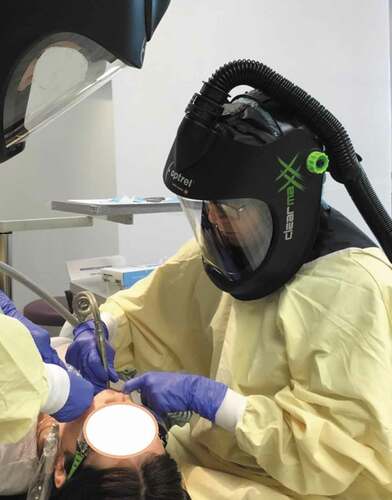
The increase in orthodontic treatment with clear aligners will continue unaffected but do-it-yourself aligner treatment [Citation39] will be under increased scrutiny as the health care industry regroups. Teledentistry will be interesting to follow. During the pandemic a number of enterprising companies arose to take advantage of the market that flourished during the time periods when everyone stayed home [Citation40]. Orthodontic patients were quick to communicate with video or images of their teeth as a screening process for emergencies or treatment progress, for example with elastics. (However, there are privacy and security issues that cannot be discounted [Citation41]. Companies may decide that their employees were more productive and keep them working from home. How will this impact orthodontic practice? Unknown but a study in the UK found overall satisfaction among patients with virtual orthodontic consultations was generally high. The majority of patients preferred more virtual appointments in the future, and it was found to be more convenient for the patient [Citation42].
Other long-term effects include the health of our patients who survived the virus, and patients who delayed needed medical or dental care the past year. Long COVID as it is being called, is now being implicated as a risk factor for other medical conditions as reported by the [Citation43]. A recent report in Nature found that Covid survivors had a 50% higher risk for diabetes [Citation44]. A more optimistic study by [Citation45], found that people who have been infected with SARS-CoV-2 will probably make antibodies against the virus for most of their lives, conferring immunity for much longer than researchers originally thought.
The growing adoption of intraoral scanning and the plasterless office will be accelerated in orthodontic practices. In addition to the obvious advantages over plaster, the pandemic brought out its advantages for infection control and simplification of workflow [Citation46].
No orthodontic conferences or meetings were held in person after March 2020. The annual session of the AAO went virtual in 2020 and 2021. Interestingly, the number of attendees to the lectures in 2020 set records, with far more attending virtually than would ever be possible in person. Unfortunately, one of the most widely anticipated orthodontic meetings in recent memory, the WFO Meeting in Yokohama, Japan, had to go virtual. The meeting was a success but the need for international collaboration and sharing of information that can only be done in person was sorely missed. Business meetings for orthodontic organizations were virtual and all indications are many will continue that way saving money and time. Future major conferences may be hybrid – in person attendance with the sessions streamed live to a remote audience, but there are serious concerns by presenters about their original content being misappropriated by unauthorized users.
In summary, orthodontics will continue to be affected by the COVID19 pandemic. The profession should embrace these changes and consider the health and safety of patients and staff, over profits and gadgetry. Orthodontists are on notice that they are still first and foremost oral health care experts and not technicians or CEOs. The changes are similar to what happened when HIV forced dentistry to adopt universal precautions. Those standards are still the primary defence against blood and airborne pathogens. The orthodontic profession must remain true to its scientific, evidence-based foundations, and treat the whole patient not just the malocclusion. This will not be the last pandemic and orthodontic research must come up with real answers to the queries originally posed in the COSA article by the AAO Council on Scientific Affairs [Citation1]. Only then will we be prepared for the next one.
Ethical approval
This review does not require an approved by the ethics committee. Everyone concurred to publication of photographs.
Disclosure statement
The author has no conflicts of interest to disclose.
References
- Marshall S, Duryea M, Huang G, et al. COVID-19: what do we know? Am J Orthod Dentofacial Orthop. 2020 Nov;158(5):e53–e62.
- Malekshoar M, Malekshoar M, Javanshir B. Challenges, limitations, and solutions for orthodontists during the coronavirus pandemic: a review. Am J Orthod Dentofacial Orthop. 2021;159(1):e59–e71.
- Tada H, Shao W, Ishimaru N, et al. The life in Japan and status of private dental office at the times of COVID-19. Oral Dis. 2021 Apr;27(Suppl 3):727–729.
- Dave M, Seoudi N, Coulthard P. Urgent dental care for patients during the COVID-19 pandemic. Lancet. 2020 Apr 18;395(10232):1257.
- Abed Al Jawad F, Alhashimi N. Orthodontic treatment pause during COVID-19 outbreak: are we overlooking potential harms to our patients and their treatment outcomes? Dental Press J Orthod. 2021 Apr 30;26(2):e21ins2.
- Cotrin P, Peloso RM, Pini NIP, et al. Urgencies and emergencies in orthodontics during the coronavirus disease 2019 pandemic: brazilian orthodontists’ experience. Am J Orthod Dentofacial Orthop. 2020 Nov;158(5):661–667.
- Bustati N, Rajeh N. The impact of COVID-19 pandemic on patients receiving orthodontic treatment: an online questionnaire cross-sectional study. J World Fed Orthod. 2020 Dec;9(4):159–163.
- ADA Health Policy Institute Survey of Dental Practice: https://www.ada.org/en/science-research/health-policy-institute/covid-19-dentists-economic-impact/survey-results. cited May 2021.
- Van Doremalen N, Bushmaker T, Morris DH, et al. Aerosol and surface stability of SARS-CoV-2 as compared with SARS-CoV-1. N Engl J Med. 2020 Apr 16;382(16):1564–1567.
- Goldman E. Exaggerated risk of transmission of COVID-19 by fomites. Lancet Infect Dis. 2020 Aug;20(8):892–893. Epub 2020 Jul 3. Erratum in: Lancet Infect Dis
- Ben-Shmuel A, Brosh-Nissimov T, Glinert I, et al. Detection and infectivity potential of severe acute respiratory syndrome coronavirus 2 (SARS-CoV-2) environmental contamination in isolation units and quarantine facilities. Clin Microbiol Infect. 2020 Dec;26(12):1658–1662.
- Mondelli MU, Colaneri M, Seminari EM, et al. Low risk of SARS-CoV-2 transmission by fomites in real-life conditions. Lancet Infect Dis. 2021 May;21(5):e112.
- Graham J, Parschal J, Paquette D. Proposed clinical guidance for orthodontists and orthodontic staff in the post-COVID-19 environment: a clinician’s perspective. J Clin Orthod. 2020 May;52(5):264–267.
- Bluth R Hit by higher prices for protective gear, doctors and dentists want insurers to pay. Kaiser Health News. Los Angeles Times. May 4, 2021.
- American Dental Association Health Policy Institute Survey of Dental Practice. Dec 2020
- Burger D Consumer confidence in returning to the dental office hits new high. ADA News April 2021.
- Holpuch A US health insurers report billions in first quarter as small providers face stress. The Guardian, May 8, 2021.
- Lamberghini F, Trifan G, Testai FD. Severe acute respiratory syndrome coronavirus 2 infection in asymptomatic pediatric dental patients. JADA. 2021;152(4):277–283.
- Meister TL, Brüggemann Y, Todt D, et al. Virucidal efficacy of different oral rinses against severe acute respiratory syndrome coronavirus 2. J Infect Dis. 2020 October 15;222(8):1289–1292.
- Davies K, Buczkowski H, Welch SR, et al. Effective inactivation of SARS-CoV-2 by commercially available mouthwashes. J Gen Virol. 2021 Apr;102(4):DOI:https://doi.org/10.1099/jgv.0.001578
- Mateos-Moreno MV, Mira A, Ausina-Márquez V, et al. Oral antiseptics against coronavirus: in-vitro and clinical evidence. J Hosp Infect. 2021 Apr 15;113: 30–43.
- Yang M, Chaghtai A, Melendez M, et al. Mitigating saliva aerosol contamination in a dental school clinic. BMC Oral Health. 2021 Feb 5;21(1):52.
- Chavis SE, Hines SE, Dyalram D, et al. Can extraoral suction units minimize droplet spatter during a simulated dental procedure? J Am Dent Assoc. 2021 Feb;152(2):157–165.
- Llandro H, Allison JR, Currie CC, et al. Evaluating splatter and settled aerosol during orthodontic debonding: implications for the COVID-19 pandemic. Br Dent J. 2021Jan;8:1–7.
- Din AR, Hindocha A, Patel T, et al. Quantitative analysis of particulate matter release during orthodontic procedures: a pilot study. Br Dent J. 2020Nov;12:1–7.
- Virdi MK, Durman K, The Debate: DS. What are aerosol-generating procedures in dentistry? A rapid review. JDR Clin Trans Res. 2021;6(2):115–127.
- Geisinger ML, Iaonnidou E. Up in the air? Future research strategies to assess aerosols in dentistry. JDR Clin Trans Res. 2021 Apr;6(2):128–131.
- Mair AD, Korne PH, Abdallah MN. Decoding dental aerosols in the age of COVID-19. J Calif Dent Assoc. 2020 Oct;48(10):533–538.
- Murdoch-Kinch CA, Johnsen DC, Wolff MS. Will the DDS class of 2021 be practice ready? J Am Dent Assoc. 2021;152(5):335–337. DOI:https://doi.org/10.1016/j.adaj.2021.03.005
- American Dental Education Association, Resilient Dental Schools, Better Oral Health Care for the Underserved. ADEA Policy Research Series Issue 3, May 2021. https://www.adea.org/policy/publications/
- Christensen GJ. Are electric handpieces an improvement? J Am Dent Assoc. 2002 Oct;133(10):1433–1434. DOI:https://doi.org/10.14219/jada.archive.2002.0061; PMID: 12403548
- Kau CH, Sameshima GT Survey of orthodontic programs, March 2020. Unpublished data.
- Kau CH, Sameshima GT Survey of orthodontic programs, July/August 2020. Unpublished data.
- Kau CH, Sameshima GT Survey of orthodontic programs, January 2021. Unpublished data.
- Meethil AP, Saraswat S, Chaudhary PP, et al. Sources of SARS-CoV-2 and other microorganisms in dental aerosols. J Dent Res. 2021 May. DOI:https://doi.org/10.1177/00220345211015948
- Meethil AP, Saraswat S, Chaudhary PP, et al. Sources of SARS- CoV-2 and other microorganisms in dental aerosols. J Dent Res. 2021 Jul;100(8):817–823. DOI:https://doi.org/10.1177/00220345211015948
- Robertson S, Ramsdale MP. Audit of qualitative fit testing for FFP3 respirators. Br Dent J. 2021Mar;11:1–4.
- Bl W. COVID-19: new considerations for respiratory protection in dental practice. J Calif Dent Assoc. 2020 Oct;48(10):539–545.
- Bous RM, Apostolopoulos K, Valiathan M. When convenience trumps quality of care: a population-based survey on direct to consumer orthodontics. Am J Orthod Dentofacial Orthop. 2021 May;159(5):e411–e422.
- Crawford E, Taylor N. The effective use of an e-dentistry service during the COVID-19 crisis. J Orthod. 2020 Dec;47(4):330–337.
- CDA Practice Support. Regulatory Compliance: teledentistry and HIPAA. J Calif Dent Assoc. 2020 Oct;48(10):573.
- Byrne E, Watkinson S. Patient and clinician satisfaction with video consultations during the COVID-19 pandemic: an opportunity for a new way of working. J Orthod. 2021 Mar;48(1):64–73.
- Centers for Disease Control and Disease Prevention. Post-COVID Conditions. April 2021. [accessed 1 May 2021]. https://www.cdc.gov/coronavirus/2019-ncov/long-term-effects.html
- Al-Aly Z, Xie Y, Bowe B. High-dimensional characterization of post-acute sequelae of COVID-19. Nature. 2021 Apr 22. DOI:https://doi.org/10.1038/s41586-021-03553-9.
- Turner JS, Kim W, Kalaidina E, et al. SARS-CoV-2 infection induces long-lived bone marrow plasma cells in humans. Nature. 2021 May 24. DOI:https://doi.org/10.1038/s41586-021-03647-4.
- Chi J. Digital Impressions and In-Office CAD/CAM: A Review of Best Practices and What's to Come. Compend Contin Educ Dent. 2021 Mar;42(3):140-141. PMID:34010575
